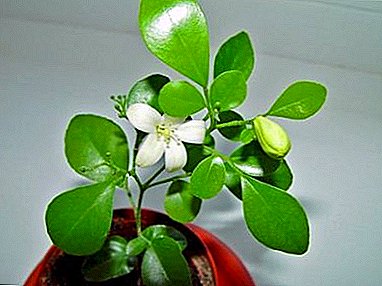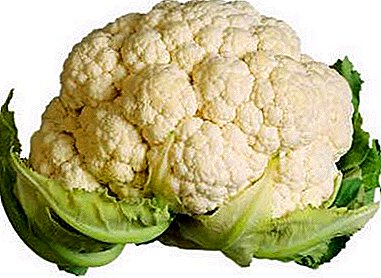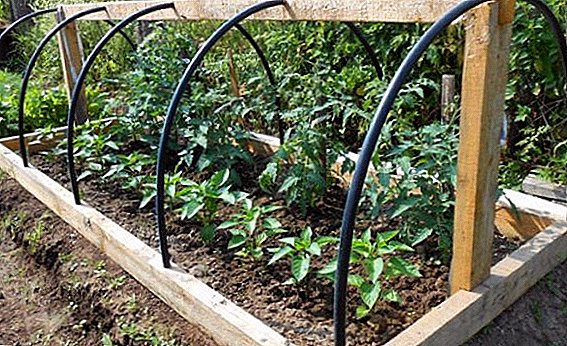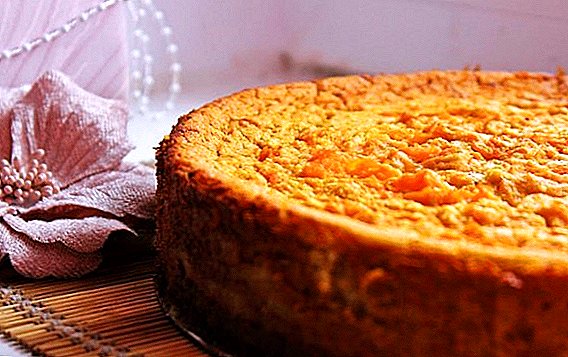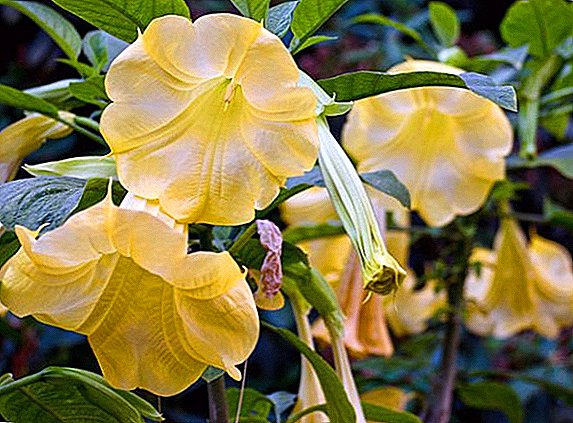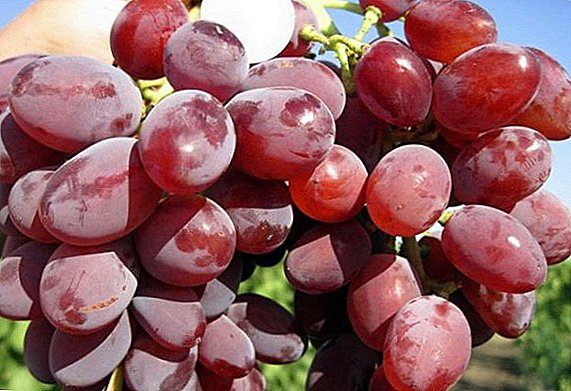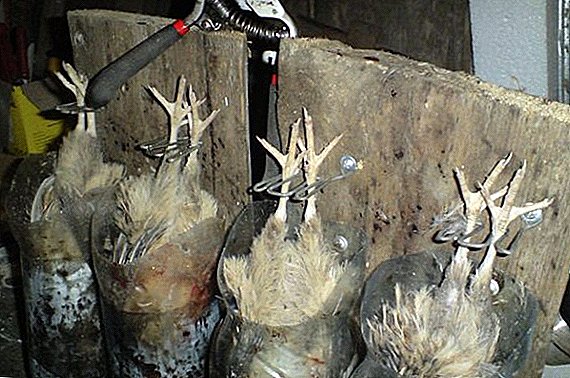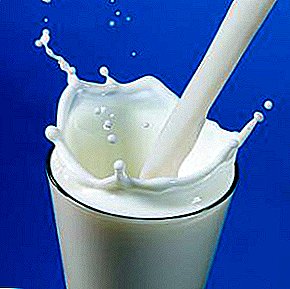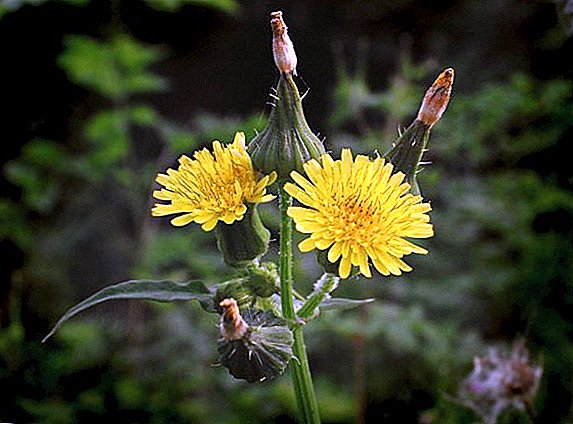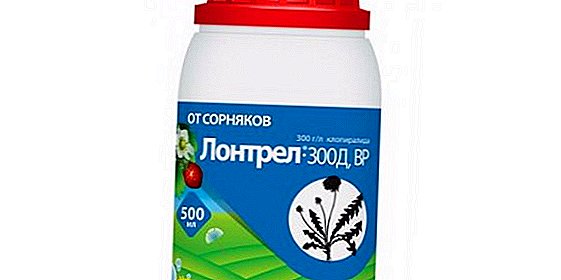 Weed control is a very important and laborious process. The quality and quantity of the crop depends on its success.
Weed control is a very important and laborious process. The quality and quantity of the crop depends on its success.
In this article we will consider one of the most effective drugs for the destruction of weeds - herbicide "Lontrel" and instructions for its use.
Herbicide "Lontrel-300": active ingredient and release form
Acting the substance of the herbicide "Lontrel 300" is clopyralid. In one liter of the drug contains 300 g of the active substance.
 Kloperalid It is a white-colored crystals, characterized by high activity on the weeds and a selective mechanism of action. Herbicide is available in the form of an aqueous solution with a capacity of 5 liters.
Kloperalid It is a white-colored crystals, characterized by high activity on the weeds and a selective mechanism of action. Herbicide is available in the form of an aqueous solution with a capacity of 5 liters.
It is worth noting that the manufacturer has recently released another, more modern preparative form "Lontrela" - "Lontrell Grand."
Active ingredient is clopyralid, only it contains it in the form of a potassium salt. Means is issued in the form of water-soluble granules. The clear advantages of the new development include:
- greater convenience during transportation and storage;
- greater efficiency in consumption (for the treatment of 3 hectares of area will need 1 liter of "Lontrela 300", while 1 kg of "Lontrela Grand" will be enough for 8 hectares).
On sale You can also find the “mini” format of the herbicide - “Lontrel 300 D”. It is released in the form of an aqueous solution by packing in 90 ml, 500 ml and 1 l, as well as in 3 ml ampoules.
Designed mainly for the treatment of lawns and strawberries.
Did you know? Kloperalid, in chemical class, is very close to the class of vitamins: it quickly collapses under the action of oxygen, does not accumulate in the soil and does not harm it.
For what crops is suitable
Lontrel is one of the most effective broad-spectrum herbicides and is designed to protect such agricultural and garden plants:
- beet;
- oats;
- winter wheat, spring;
- rice;
- barley;
- strawberries;
- linen;
- digitalis;
- raygars;
- lavender
- Maclea;
- bow;
- garlic.

The mechanism and spectrum of action of this drug
"Lontrel 300" - systemic herbicide. Getting on the plants, it is absorbed by their leaves and quickly penetrates the root system. Herbicide replaces plant hormones and blocks their functionality.
This leads to a serious disruption of metabolism and growth, as a result - the death of weeds.

The drug has a selective effect and detrimental effect only on certain types of annual and perennial weeds.
With the help of "Lontrela" you can get rid of these weeds:
- chamomile is not odorous;
- buckwheat;
- thistlehead;
- latuka;
- bodie;
- gore;
- dandelion;
- ambrosia;
- blue cornflower, flattened;
- milk thistle;
- sunflower self seeding.
Important! "Lontrel 300 "also destroys plants such as sorrel, plantain, yarrow, chamomile. However, they can not always be attributed to the weeds.In this case, the tool is ineffective against colza, Yartik, schiritsi, Mari, zheruhi. For crops, the drug is completely harmless, that is, it does not produce a phytotoxic effect.
You can overcome the weeds in the garden if you plow the virgin soil with the help of a motor tractor, a tractor or a cultivator.The following damage symptoms are found in plants susceptible to Lontrel:
- curvature of stalks and shoots;
- stunting;
- thickening of the stem, the formation of cracks on it;
- twisting foliage.
Advantages of the Lontrel-300 herbicide
Lontrel-300 has been used for weed control for more than twenty years, and during this time it has proven itself very well in this field. The benefits of herbicide include:
- has a wide range of effects;
- differs in the minimum terms of destruction of weeds;
- does not harm the soil;
- non-toxic to protected agricultural crops;
- not addictive in weeds;
- destroys not only the above-ground part of the weeds, but also the root system, which is especially important in the fight against the thistle;
- the preparation is not afraid of precipitation that fell within an hour after treatment.
 Today the manufacturer developed improved herbicide formulations ("Lontrel Grand", "Lontrel-300D") in the form of water-soluble granules, which are more convenient in storage, transportation and more economical to use.
Today the manufacturer developed improved herbicide formulations ("Lontrel Grand", "Lontrel-300D") in the form of water-soluble granules, which are more convenient in storage, transportation and more economical to use.Compatibility with other pesticides
"Lontrel" is allowed to mix with drugs that are used in the fight against annual dicotyledonous weeds, insecticides, fungicides, growth regulators and liquid fertilizers.
In this case, before mixing, it is necessary to ascertain whether there are any contraindications according to the instructions, as well as to mix the test solution in a small container in order to check physical fitness for mixing. Obvious signs of drug incompatibility relate:
- delamination of liquids;
- lump formation;
- the appearance of spots of a different color.
Did you know? "Lontrel "is often used in the preparation of universal mixtures for fertilizing and improving the growth of beets. Lack of weeds is the key to good nutrition and, consequently, rapid plant growth.The drug is well compatible with such means as:
- "Biceps";
- "Miura";
- "Graminon";
- Zeplek.
Method of application: solution preparation and consumption rate
To prepare the solution of the herbicide "Lontrel 300" you need to strictly according to the instructions, so as not to harm the plants to be protected. Spraying should be carried out only with a freshly prepared mixture (it is not recommended to store it for more than one and a half hours).
Before using the drug is well razbaltyvat in the factory capacity. Herbicide is mixed with water in accordance with the norms of consumption specified in the instructions. First, 1/3 of the tank must be filled with water, add the preparation, mix thoroughly, then top up the rest of the water and mix again. Recommended consumption rate: 300-400 liters per hectare. 
For more effective action drug treatment should be carried out at air temperatures from + 10 ° C to + 25 ° C, on a calm calm day.
In case of significant contaminationas well as in the fight against bitterness or thistle should use the highest rate of consumption of the specified in the variation. The mixture must be evenly sprayed on the leaf surface of the plant.
Important! The treatment is recommended during the period of active development of weeds - with the appearance of 5-10 leaves in annual weeds and 10-15 - in perennials (rosette formation).Depending on the type of crops, it is recommended to use such consumption rates (l / ha):
- wheat, oats, barley - from 0, 16 to 0, 66;
- sugar beet - from 0.3 to 0, 5;
- flax - from 0, 1 to 0, 3;
- strawberries - from 0, 5 to 0, 6;
- raygars - 0, 3;
- digitalis - from 0, 2 to 0, 3;
- rape, maclaya - from 0, 3 to 0, 4;
- lavender - 0.5;
- lawns - from 0, 16 to 0, 66.
You protect your crop from weeds by applying such fungicides: "Hom", "Skor", "Strobe", "Fundazol", "Alirin B" and "Topaz".
Impact speed and period of protective action

"Lontrel" begins its action after a couple of hours after spraying.
Plant growth slows down, and visible signs of damage to weeds appear after about 13-17 hours. After 1.5 weeks, the leaves noticeably curl and discolor, and after about 14 days after spraying, the weeds die off altogether.
The duration of the protection is saved throughout the growing season weed plants, which shoots were on the site during processing.
Security measures
The drug belongs to third grade hazard (moderately hazardous). It does not cause skin irritation or damage to the respiratory tract mucous, non-toxic to birds, fish, moderate toxic to domestic animals.
Not dangerous for bees. However, it is a chemical agent, which means that the treatment with Lontrell 300 requires the use of the following safety measures:
- when working with a herbicide, you need to protect all areas of the body with clothes, use gloves, a mask or respirator, hide hair under a headdress, protect your eyes with glasses;
- in the process of preparing the mixture and spraying not to eat food and drinks;
- do not use in food processing capacity;
- after spraying, wash hands well with soap;
- do not process flowering pollinating plants during the period of bee activity;
- spraying is carried out in the morning (until 10.00) or in the late afternoon (after 18.00) on a windless day;
- during spraying and a couple of hours after it, do not allow animals to the treated area.

Did you know? The safe zone for placement of beehives from the cultivated area is 4 km.
First aid for poisoning
In cases of direct contact with the drug, you must perform the following steps:
- in case of contact with the skin - thoroughly rinse the area under running water;
- if the solution gets into the eyes, rinse them well under the flow water for five minutes, with prolonged serbezh or reddening of the eyes, a sudden deterioration of visual acuity - contact an optometrist;
- if ingested, drink large amounts of water and take activated carbon, based on body weight.


A person who is unconscious cannot vomit.
If you feel dizzy or have shortness of breath from inhaling the vapors of the solution - you need to go out into the fresh air. There is no specific antidote to Lontrel, therefore only symptomatic treatment is carried out.
Shelf life and storage conditions
The drug can be stored no more than three years in an airtight factory container. The herbicide should be placed in a dry, shaded, well ventilated, not accessible to children place. Store at + 5 ° C to + 40 ° C.
How to remove unnecessary weeds from the site, see this video.



